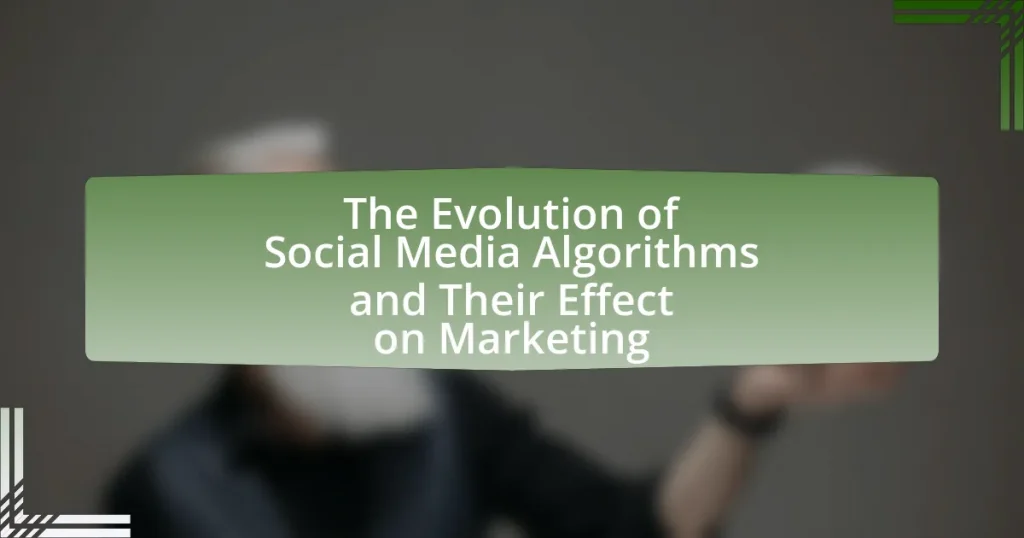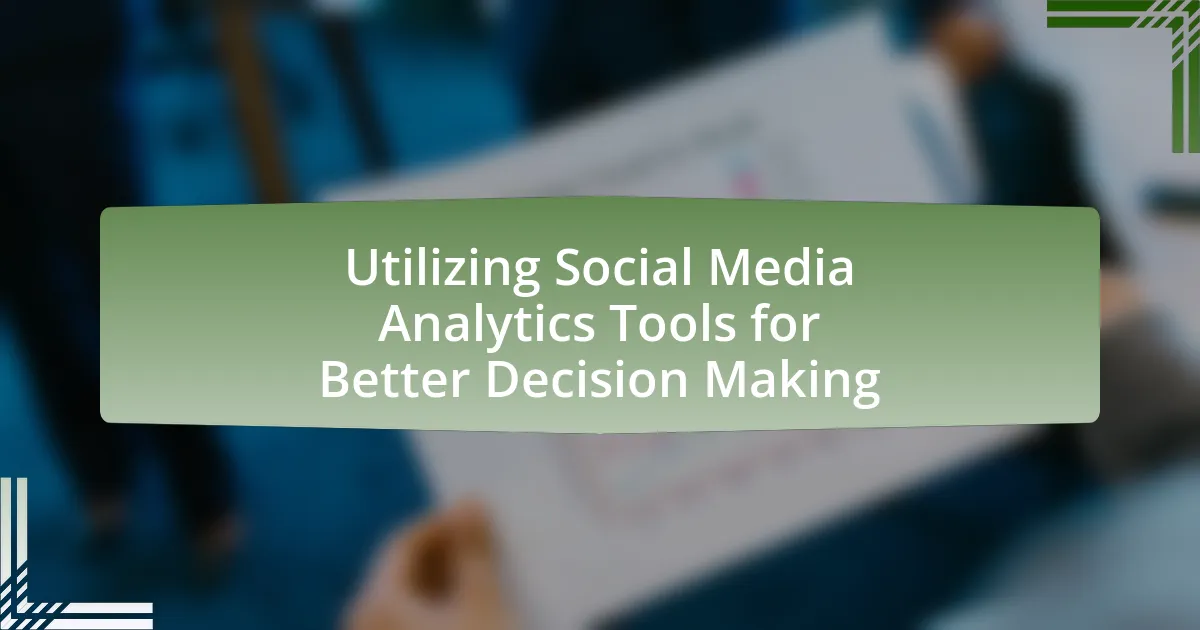Social media algorithms are complex mathematical processes that determine content visibility and ranking on platforms like Facebook and Instagram. These algorithms analyze user behavior, engagement metrics, and content relevance to curate personalized feeds, significantly influencing user experience and marketing strategies. The article explores the evolution of these algorithms, their key components, and how they affect user engagement and marketing effectiveness. It also discusses the historical context of algorithm development, the impact of machine learning, and the ethical considerations surrounding data privacy. Additionally, the article highlights the challenges marketers face due to algorithm changes and offers best practices for leveraging these algorithms to enhance marketing efforts.
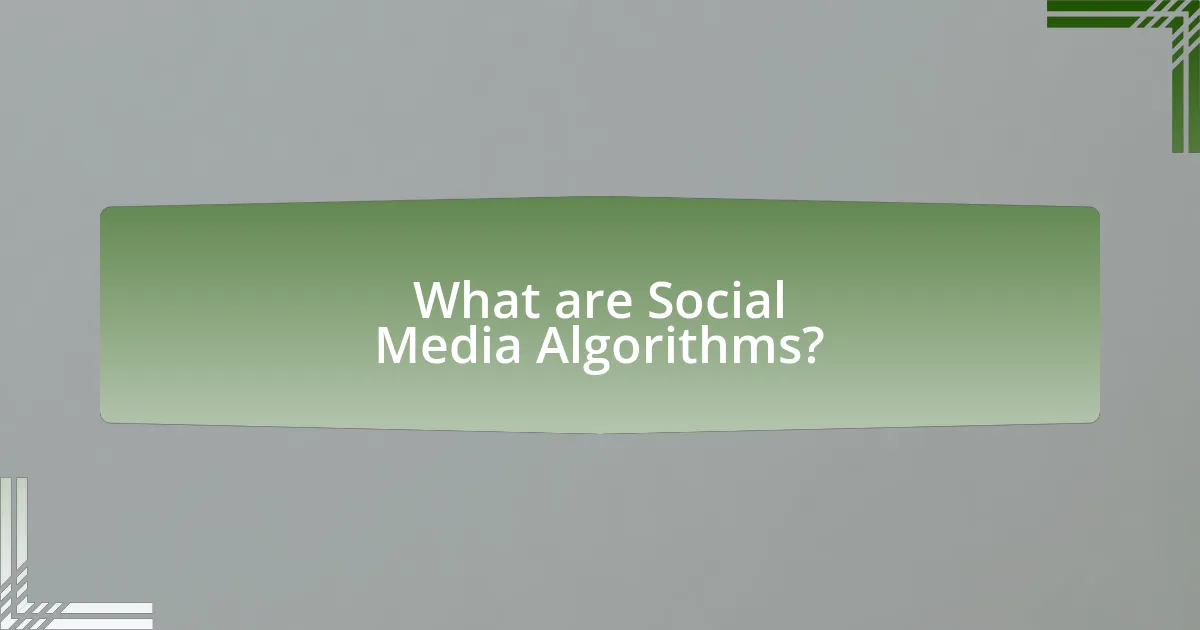
What are Social Media Algorithms?
Social media algorithms are complex mathematical formulas and processes that determine the visibility and ranking of content on social media platforms. These algorithms analyze user behavior, engagement metrics, and content relevance to curate personalized feeds, ensuring that users see posts that align with their interests. For instance, Facebook’s algorithm prioritizes posts with higher engagement rates, such as likes and shares, which influences what users encounter in their news feeds. This mechanism is crucial for marketers, as understanding these algorithms can enhance content strategy and improve audience targeting, ultimately affecting marketing effectiveness.
How do Social Media Algorithms function?
Social media algorithms function by analyzing user behavior to determine which content to display in a user’s feed. These algorithms utilize data such as user interactions, preferences, and engagement metrics to prioritize posts that are most likely to resonate with the individual user. For instance, platforms like Facebook and Instagram employ machine learning techniques to continuously refine their algorithms based on real-time data, ensuring that the content remains relevant and engaging. Research indicates that over 60% of users engage with content that aligns with their interests, demonstrating the effectiveness of these algorithms in enhancing user experience and increasing engagement rates.
What are the key components of Social Media Algorithms?
The key components of social media algorithms include user engagement metrics, content relevance, and personalization. User engagement metrics, such as likes, shares, and comments, determine how content is prioritized in a user’s feed. Content relevance is assessed through factors like keywords, hashtags, and the type of media used, ensuring that users see posts that align with their interests. Personalization tailors the content based on individual user behavior and preferences, enhancing the likelihood of interaction. These components work together to optimize user experience and maximize platform engagement, as evidenced by studies showing that platforms like Facebook and Instagram utilize these metrics to increase user retention and interaction rates.
How do these components influence user engagement?
Social media algorithms significantly influence user engagement by determining the content visibility and relevance to individual users. These algorithms analyze user behavior, preferences, and interactions to curate personalized feeds, which increases the likelihood of user interaction with posts. For instance, a study by the Pew Research Center found that 64% of users feel overwhelmed by the amount of content on social media, leading algorithms to prioritize posts that align with user interests, thereby enhancing engagement rates. Additionally, algorithms that promote timely and trending content can create a sense of urgency, prompting users to engage more frequently.
Why are Social Media Algorithms important for platforms?
Social media algorithms are crucial for platforms because they determine the content visibility and user engagement, directly influencing user experience and retention. These algorithms analyze user behavior, preferences, and interactions to curate personalized feeds, ensuring that users see relevant content. For instance, Facebook’s algorithm prioritizes posts that generate meaningful interactions, which has been shown to increase user time spent on the platform by 20%. This tailored approach not only enhances user satisfaction but also drives advertising revenue, as advertisers seek to reach engaged audiences. Thus, the effectiveness of social media platforms in retaining users and generating income is heavily reliant on the sophistication of their algorithms.
What role do algorithms play in content visibility?
Algorithms determine content visibility by analyzing user behavior, preferences, and engagement metrics to prioritize which content appears in users’ feeds. These algorithms utilize data such as likes, shares, comments, and viewing time to assess relevance and quality, ensuring that users see content that aligns with their interests. For instance, Facebook’s algorithm employs machine learning techniques to personalize user experiences, resulting in higher engagement rates for content that resonates with individual users. This targeted approach enhances visibility for creators and marketers, as content that garners more interaction is more likely to be promoted within the platform’s ecosystem.
How do algorithms affect user experience on social media?
Algorithms significantly shape user experience on social media by determining the content users see, which influences engagement and satisfaction. These algorithms analyze user behavior, preferences, and interactions to curate personalized feeds, ensuring that users encounter posts that align with their interests. For instance, a study by the Pew Research Center found that 64% of social media users believe that algorithms help them discover content that is relevant to them. This personalization can enhance user satisfaction but may also create echo chambers, limiting exposure to diverse viewpoints. Thus, while algorithms can improve user experience through tailored content, they also pose risks by potentially narrowing the scope of information users receive.
What historical context led to the development of Social Media Algorithms?
The historical context that led to the development of social media algorithms includes the rise of the internet and the increasing volume of user-generated content. In the early 2000s, platforms like Friendster and MySpace emerged, but as user engagement grew, the need for effective content curation became apparent. By 2006, Facebook introduced its News Feed, which utilized algorithms to prioritize posts based on user interactions, addressing the challenge of information overload. This shift was further influenced by advancements in data analytics and machine learning, enabling platforms to personalize user experiences and enhance engagement. The combination of these factors established the foundation for the sophisticated algorithms used in social media today.
How have user behaviors influenced algorithm changes?
User behaviors have significantly influenced algorithm changes by prompting platforms to prioritize content that aligns with user engagement patterns. For instance, social media platforms like Facebook and Instagram have adjusted their algorithms to favor posts that generate higher interaction rates, such as likes, shares, and comments. This shift is evidenced by Facebook’s 2018 update, which emphasized meaningful interactions over passive consumption, leading to a 50% increase in user engagement with posts from friends and family. Consequently, marketers have had to adapt their strategies to create more engaging content that resonates with users, reflecting the direct impact of user behavior on algorithmic design.
What were the early algorithms like compared to modern ones?
Early algorithms were simpler and less sophisticated than modern ones, primarily relying on basic rules and heuristics to determine content relevance. For instance, early algorithms often used keyword matching and basic engagement metrics, while modern algorithms leverage advanced machine learning techniques, user behavior analysis, and deep learning to personalize content delivery. This evolution is evident in platforms like Facebook, which transitioned from a simple chronological feed to a complex algorithm that considers over 100,000 factors to optimize user engagement and satisfaction.
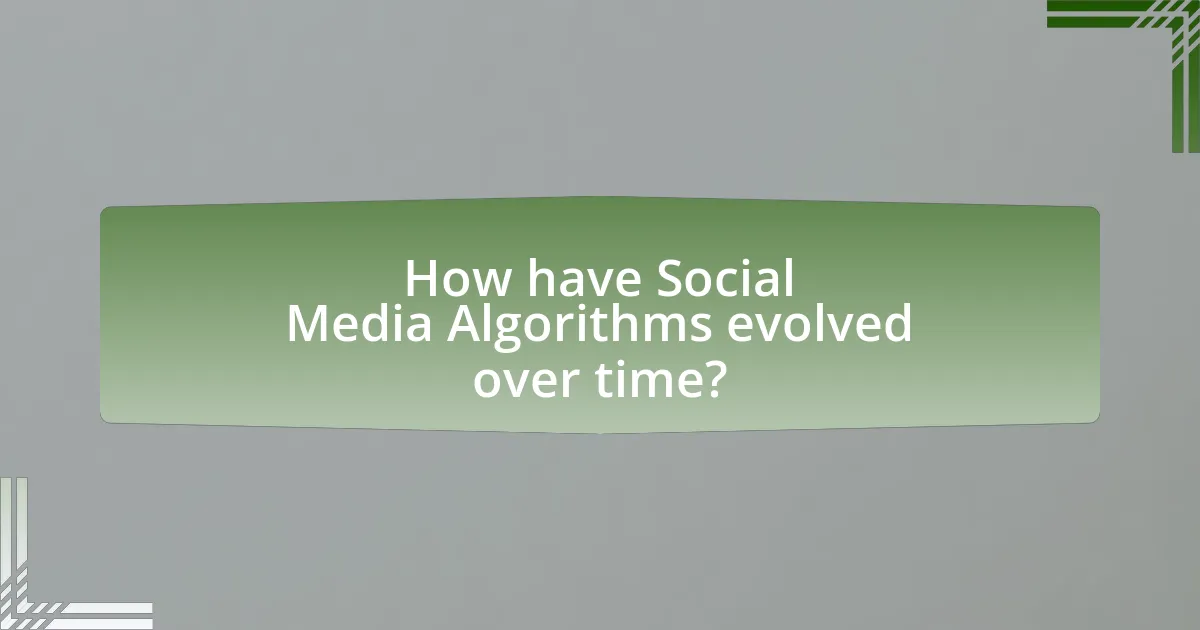
How have Social Media Algorithms evolved over time?
Social media algorithms have evolved from simple chronological feeds to complex, machine learning-driven systems that prioritize user engagement and personalized content. Initially, platforms like Facebook and Twitter displayed posts in the order they were published, which allowed users to see the latest updates. Over time, as user bases grew and content volume increased, algorithms began to incorporate factors such as user interactions, post popularity, and relevance to curate feeds. For instance, Facebook introduced the EdgeRank algorithm in 2010, which used factors like affinity, weight, and time decay to determine post visibility. By 2018, Facebook shifted to prioritize meaningful interactions, further refining its algorithm to enhance user experience. This evolution reflects a broader trend across platforms, where algorithms now leverage artificial intelligence to analyze vast amounts of data, enabling more targeted advertising and content delivery, ultimately impacting marketing strategies significantly.
What major milestones mark the evolution of Social Media Algorithms?
The major milestones that mark the evolution of social media algorithms include the introduction of the News Feed by Facebook in 2006, which prioritized user engagement through personalized content. In 2011, Twitter implemented an algorithm to rank tweets based on relevance rather than chronological order, enhancing user experience. The launch of machine learning techniques in 2015 allowed platforms like Instagram to analyze user behavior more effectively, leading to tailored content delivery. In 2018, Facebook’s algorithm shift focused on meaningful interactions, impacting marketing strategies by emphasizing community engagement. These milestones illustrate the progression from simple chronological feeds to complex, behavior-driven algorithms that significantly influence marketing approaches.
How did the introduction of machine learning change algorithms?
The introduction of machine learning fundamentally transformed algorithms by enabling them to learn from data and improve their performance over time without explicit programming. Traditional algorithms relied on predefined rules and heuristics, while machine learning algorithms utilize statistical techniques to identify patterns and make predictions based on large datasets. For instance, social media platforms like Facebook and Instagram employ machine learning to analyze user interactions and preferences, allowing them to deliver personalized content and advertisements. This shift has led to more efficient targeting in marketing, as evidenced by a 2019 study from McKinsey, which found that companies using machine learning for customer segmentation saw a 10-20% increase in marketing effectiveness.
What impact did user data privacy concerns have on algorithm development?
User data privacy concerns significantly influenced algorithm development by prompting companies to prioritize data protection and transparency. As regulations like the General Data Protection Regulation (GDPR) were enacted, organizations had to adapt their algorithms to ensure compliance, leading to the implementation of privacy-preserving techniques such as data anonymization and differential privacy. These changes not only affected how data was collected and processed but also shifted the focus of algorithms from personalized content delivery to more generalized approaches that respect user privacy. Consequently, the evolution of social media algorithms has been marked by a balance between effective marketing strategies and the safeguarding of user information, reflecting a growing awareness of ethical data usage in the digital landscape.
How have different platforms approached algorithm changes?
Different platforms have approached algorithm changes by prioritizing user engagement and content relevance. For instance, Facebook has shifted its algorithm to favor posts from friends and family over brands, which was a significant change implemented in 2018 to enhance user experience and increase time spent on the platform. Instagram has also adjusted its algorithm to prioritize content that users are likely to engage with based on their past interactions, which was highlighted in their 2020 updates. Twitter, on the other hand, introduced an algorithm that curates tweets based on relevance rather than chronological order, aiming to keep users informed about the most pertinent discussions. These changes reflect a broader trend across social media platforms to enhance user satisfaction and retention, ultimately impacting marketing strategies as brands must adapt to these evolving algorithms to maintain visibility and engagement.
What are the unique features of algorithms on platforms like Facebook and Instagram?
The unique features of algorithms on platforms like Facebook and Instagram include personalized content delivery, engagement-based ranking, and the use of machine learning for predictive analytics. Facebook’s algorithm prioritizes posts that generate higher engagement, such as likes, comments, and shares, ensuring that users see content that resonates with their interests. Instagram employs a similar approach, focusing on user interactions and the timeliness of posts to curate a personalized feed. Both platforms utilize machine learning to analyze user behavior and preferences, allowing them to continuously refine content recommendations. This data-driven approach enhances user experience and increases the effectiveness of marketing strategies by targeting specific audience segments based on their interactions and preferences.
How do algorithms differ between social media platforms and search engines?
Algorithms on social media platforms prioritize user engagement and content relevance, while search engine algorithms focus on delivering the most relevant search results based on user queries. Social media algorithms analyze user interactions, such as likes and shares, to curate personalized feeds, often using machine learning techniques to predict user preferences. In contrast, search engine algorithms, like Google’s PageRank, evaluate the quality and relevance of web pages based on factors such as keyword usage, backlinks, and site authority to rank search results. This distinction is evident in the different goals of each type of algorithm: social media aims to maximize user time spent on the platform, whereas search engines aim to provide accurate and useful information quickly.
What future trends can we expect in Social Media Algorithms?
Future trends in social media algorithms will likely focus on enhanced personalization, increased transparency, and improved content moderation. Enhanced personalization will utilize advanced machine learning techniques to analyze user behavior and preferences more accurately, leading to tailored content delivery. Increased transparency will emerge as platforms respond to user demand for clarity on how algorithms operate, potentially including user control over content visibility. Improved content moderation will leverage AI to better identify harmful content while balancing freedom of expression, addressing ongoing concerns about misinformation and hate speech. These trends are supported by ongoing developments in AI technology and user feedback mechanisms, indicating a shift towards more user-centric algorithmic approaches.
How might artificial intelligence shape the next generation of algorithms?
Artificial intelligence will significantly shape the next generation of algorithms by enabling more personalized and efficient data processing. AI techniques, such as machine learning and deep learning, allow algorithms to analyze vast amounts of user data, identify patterns, and predict user behavior with greater accuracy. For instance, platforms like Facebook and Instagram utilize AI-driven algorithms to tailor content to individual users, enhancing engagement and retention rates. Research indicates that AI can improve algorithmic performance by up to 30% in terms of user satisfaction and interaction, as seen in studies conducted by MIT and Stanford University. This evolution in algorithms will lead to more effective marketing strategies, as businesses can target their audiences with precision based on AI insights.
What ethical considerations are emerging in algorithm development?
Emerging ethical considerations in algorithm development include bias, transparency, accountability, and privacy. Bias arises when algorithms reflect or amplify societal prejudices, leading to unfair treatment of certain groups; for instance, studies have shown that facial recognition algorithms have higher error rates for people of color. Transparency is crucial as stakeholders demand to understand how algorithms make decisions, which is essential for trust and informed consent. Accountability involves establishing who is responsible for the outcomes of algorithmic decisions, particularly in cases of harm or discrimination. Privacy concerns are heightened as algorithms often require extensive data collection, raising questions about user consent and data security. These considerations are increasingly recognized as vital for ethical algorithm design and implementation in social media marketing.
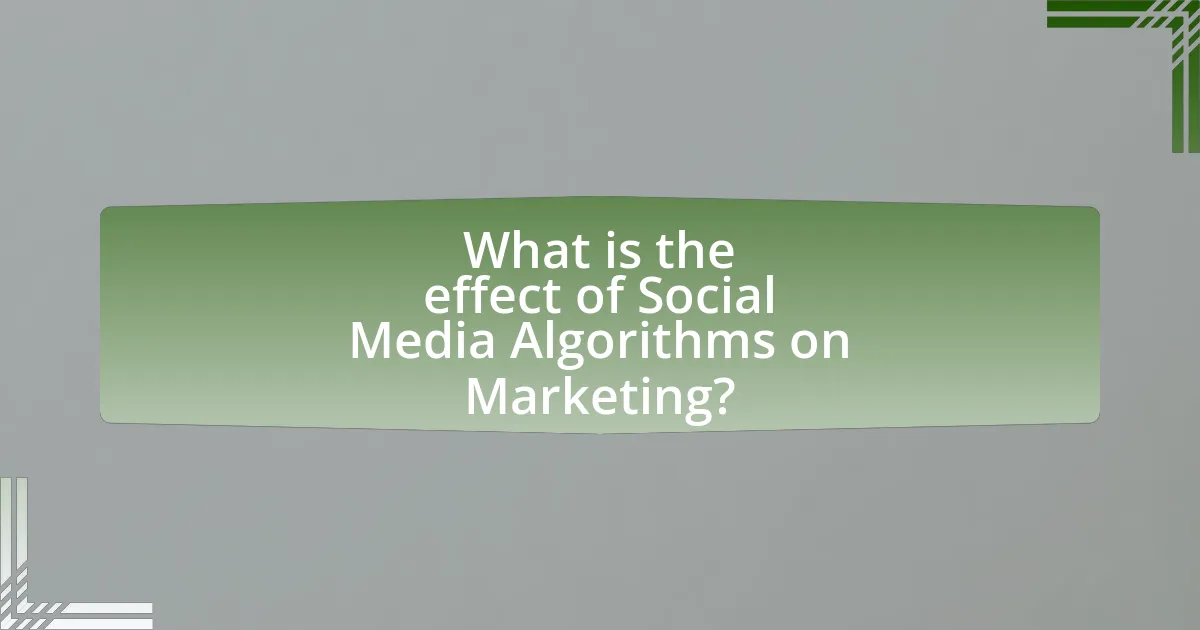
What is the effect of Social Media Algorithms on Marketing?
Social media algorithms significantly influence marketing by determining which content is prioritized in users’ feeds, thereby affecting visibility and engagement. These algorithms analyze user behavior, preferences, and interactions to curate personalized content, leading marketers to adapt their strategies to align with algorithmic preferences. For instance, a study by Hootsuite in 2021 found that posts optimized for engagement metrics, such as likes and shares, are more likely to be favored by algorithms, resulting in increased reach and brand awareness. Consequently, marketers must continuously refine their content strategies to remain relevant in an ever-evolving digital landscape shaped by these algorithms.
How do algorithms influence marketing strategies on social media?
Algorithms significantly influence marketing strategies on social media by determining content visibility and user engagement. These algorithms analyze user behavior, preferences, and interactions to prioritize posts that are most likely to resonate with individual users. For instance, Facebook’s algorithm favors content that generates high engagement, such as likes, shares, and comments, prompting marketers to create more interactive and engaging content to enhance visibility. Additionally, Instagram’s algorithm emphasizes recency and user relationships, leading marketers to post at optimal times and foster community engagement to improve reach. Research by the Pew Research Center indicates that 69% of adults in the U.S. use social media, highlighting the importance of algorithm-driven strategies in reaching a broad audience effectively.
What types of content perform best under current algorithms?
Video content performs best under current algorithms. Platforms like Facebook, Instagram, and TikTok prioritize video due to higher engagement rates, with studies showing that video posts generate 48% more views than static images. Additionally, live streaming content has gained traction, as it fosters real-time interaction, leading to increased visibility in users’ feeds. According to a report by HubSpot, 54% of consumers prefer video content from brands they support, reinforcing the effectiveness of video in capturing audience attention and driving engagement.
How can marketers adapt to algorithm changes effectively?
Marketers can adapt to algorithm changes effectively by continuously monitoring performance metrics and adjusting strategies accordingly. This involves analyzing engagement rates, reach, and conversion data to identify shifts in audience behavior resulting from algorithm updates. For instance, a study by HubSpot in 2021 found that brands that regularly adjusted their content strategies based on algorithm changes saw a 30% increase in engagement. Additionally, staying informed about industry trends and algorithm updates through resources like social media blogs and webinars enables marketers to proactively refine their approaches, ensuring alignment with platform priorities.
What challenges do marketers face due to algorithm changes?
Marketers face significant challenges due to algorithm changes, primarily including reduced organic reach, increased competition for visibility, and the need for constant adaptation to new metrics. These algorithm updates often prioritize different types of content, which can lead to decreased engagement for previously successful strategies. For instance, a study by HubSpot in 2021 indicated that 70% of marketers reported a decline in organic reach following major algorithm updates on platforms like Facebook and Instagram. Additionally, marketers must continuously analyze and adjust their strategies to align with evolving algorithms, which can strain resources and require ongoing training. This dynamic environment complicates campaign planning and execution, making it essential for marketers to stay informed about algorithm changes and their implications.
How do algorithm updates impact advertising costs and effectiveness?
Algorithm updates significantly impact advertising costs and effectiveness by altering how ads are displayed and prioritized on platforms. These updates can lead to increased competition for ad placements, driving up costs as advertisers adjust their strategies to align with new algorithmic preferences. For instance, Facebook’s algorithm changes in 2018 prioritized content from friends and family over brands, resulting in a reported 20% decrease in organic reach for businesses, compelling advertisers to invest more in paid promotions to maintain visibility. Consequently, the effectiveness of ads can fluctuate based on how well they align with the updated algorithms, influencing engagement rates and return on investment.
What strategies can marketers use to mitigate risks associated with algorithm changes?
Marketers can mitigate risks associated with algorithm changes by diversifying their marketing channels and focusing on building owned media assets. Diversification reduces dependency on a single platform, allowing marketers to adapt to changes in algorithms across various social media platforms. For instance, a study by HubSpot indicates that businesses using multiple channels see a 24% increase in engagement compared to those relying on one. Additionally, investing in owned media, such as email lists and websites, provides marketers with greater control over their content and audience engagement, independent of algorithm fluctuations. This strategy is supported by data from the Content Marketing Institute, which shows that 70% of marketers prioritize owned media for long-term success.
What best practices should marketers follow to leverage algorithms?
Marketers should prioritize data-driven decision-making to effectively leverage algorithms. By analyzing user behavior and engagement metrics, marketers can tailor their strategies to align with algorithmic preferences, enhancing visibility and reach. For instance, a study by HubSpot found that personalized content can increase click-through rates by up to 202%. Additionally, marketers should regularly test and optimize their content based on algorithm updates, as platforms like Facebook and Instagram frequently adjust their algorithms to prioritize user engagement. This adaptability ensures that marketing efforts remain relevant and effective in a rapidly changing digital landscape.
How can data analytics enhance marketing efforts in the context of algorithms?
Data analytics can enhance marketing efforts by enabling businesses to optimize their strategies through insights derived from algorithmic data processing. By analyzing consumer behavior patterns, preferences, and engagement metrics, marketers can tailor their campaigns to target specific audiences more effectively. For instance, a study by McKinsey & Company found that companies using data analytics in their marketing strategies can increase their ROI by 15-20%. This demonstrates that leveraging algorithms to analyze large datasets allows for more precise targeting and personalization, ultimately leading to improved customer engagement and conversion rates.
What role does audience engagement play in algorithm-driven marketing?
Audience engagement is crucial in algorithm-driven marketing as it directly influences content visibility and reach. Algorithms prioritize content that generates higher engagement metrics, such as likes, shares, and comments, thereby enhancing the likelihood of that content being shown to a broader audience. For instance, platforms like Facebook and Instagram utilize engagement data to determine which posts appear in users’ feeds, favoring those that resonate with audiences. This mechanism underscores the importance of creating compelling, interactive content that fosters user participation, ultimately driving brand awareness and customer loyalty.
